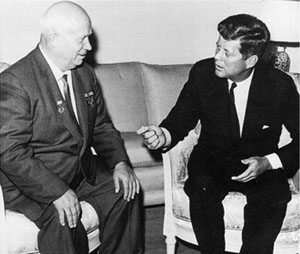![]()
During the Cold War from 1945 to 1990, there were numerous "stare-down" incidents between the United States and the Soviet Union, including the Cuban Missile Crisis and the erection of the Berlin Wall.
What you must do in this unit
- Read the textbook chapter 36 and pages 527-34.
- Check the remarks by Professor Evans on the Cold War, the notes for HIS 135 on the Cold War, and then watch my short video on the Cold War.
- Study the Questions to Consider and the Key Terms for the Unit.
- Submit the Secret Speech paragraph.
What you can do in this unit
- Read my notes on the Death Mask of Stalin.
- Check out my paper on Evgenii Varga, soviet economist, and his work in analyzing capitalism after World War 2.
- You can also read my old paper on Soviet efforts in the 1970 to promote communism in Ethiopia.
- Read some Recollections of the Cold War in Bulgaria by one of my former students.
- What do dominoes have to do with the study of the Cold War?
- Ever hear of NSC-68?
- Was Radio Liberty a bit premature in asserting the prospects for the downfall of communism in Eastern Europe? Read the pamphlet, A Fresh Look at Liberation, from 1957?
- So, what was it like, studying the international situation in the summer of 1948? Have a look at the notes of Professor Hammond, "The U.S. and Russian Today," (*.PDF file) from that time. The check his similar lecture from 1958, only ten years later, but entitled, "Who Will Win?" (*.PDF file) Yes, the Cold War was really seen in such terms, a "zero-sum" game.
- We also have a list of some useful websites on the web that deal with world communism.
- Well, I have all this material from Professor Hammond. One of the more interesting items that I have is the outline to the edited book (*.PDF file) that Hammond put together in 1971 (revised 1975), Anatomy of Communist Takeovers, in which experts wrote case studies of specific communist takeovers from the 1920s to the 1960s. Hammond's outline neatly summarizes the key points to be covered in all of the case studies and then some of the general conclusions to be reached about communist takeovers. It is an excellent book!
- You can read about the Nike anti-aircraft system that was installed to protect Washington, DC from a Soviet bomber attack in the 1950s and 1960s. Dr. Christopher John Bright focuses on the Nike missile batteries that were set up in Fairfax County in the 1950s/1960s. Log into Canvas and look for the article entitled "Bright Article on Nike Missile Batteries" under "Course Documents."
- Kerry Hite, former student, has written a short explanation of how official documents are declassified for inclusion in the important series, Foreign Relations of the United States, published by the Department of State.
Some videos that you can watch for this unit
- The Cold WR - Part 1: From World War to Cold War
- Berlin Airlift
- Propaganda: Your Job in Germany Professor Campion adds: "The clip is from a US military training film produced to prepare American soldiers for their occupation of Germany. The film provides insight into the occupation which helped solidify the Cold War dynamic on the international stage."
- Korean War Overview
- JFK and Nixon debate on the Cold War
- Duck and Cover - Nuclear Safety & the Cold War
- The Korean War, A History. By Bruce Cumings - Part 1
- Korean War 1950 to 1953 - Part 1 of 3
- Cuban Missile Crisis
- China: The Roots of Madness (1967)
- Vietnam War
- Biography of Ho Chi Minh
- For extra credit please suggest to your instructor a relevant video for this unit of the course. Send the title of the video, the URL and a brief explanation of why you find the video interesting and applicable to the material that is being studied in this unit.
Extra Credit Options
- For up to 25 points of extra credit, read George Kennan's "The Sources of Soviet Conduct," and, in a one-page paper, given the benefit of hindsight, assess the accuracy of Kennan's remarks almost fifty years later. Kennan's "Long Telegram," which he posted from Moscow in 1946 is also online, and a bit more hard-edged than the "Sources" article which was published in the journal Foreign Affairs.
- For up to 25 points of extra credit, read Thomas T. Hammond, ed., The Anatomy of Communist Takeovers (1971) and write a one-page paper explaining the process of the typical "communist takeover."
- For up to 25 points of extra credit, read Milovan Djilas, Conversations with Stalin (1962) and write a one-page paper in which you explain Djilas' portrayal of Stalin.
- For 25 points maximum of extra credit, compare and contrast the NATO and Warsaw pact treaties in a paragraph.
- For up to 10 points of extra credit, watch The Russians Are Coming, the Russians Are Coming! and write a long paragraph about the movie's capture of a moment in the 1960s.
Unit Learning Objectives
- Upon successful completion of this unit, you will be able to (1) identify key events in the course of the Cold War, (2) explain how both the United States and the Soviet Union supported proxy forces in conflicts during the Cold War and (3) analyze a historical primary source.
